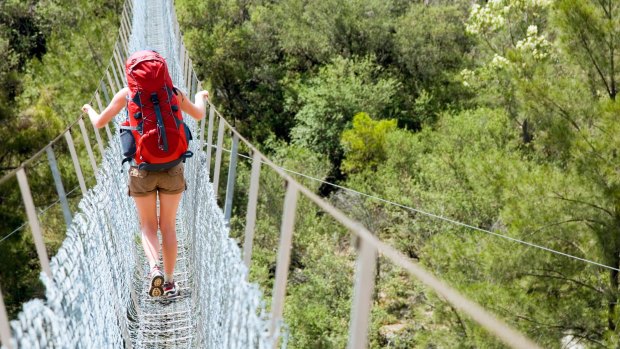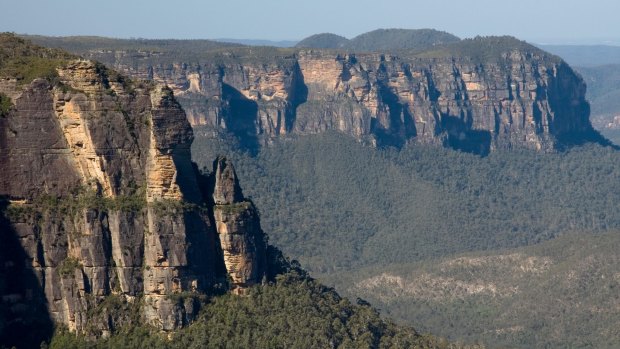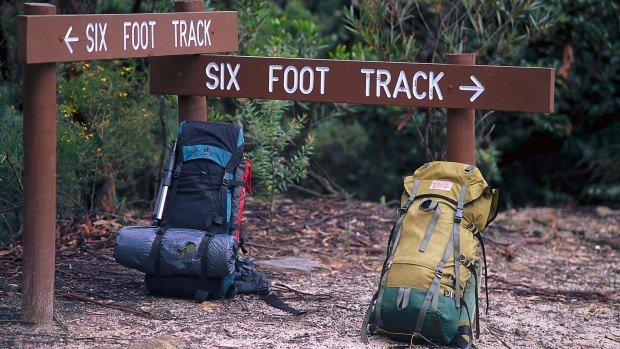This was published 2 years ago
Six Foot Track, Blue Mountains: A historic shortcut is now one of NSW's best hikes

The Bowtell Swing Bridge, a narrow, precarious-looking suspension bridge built in 1991 by the 1st Field Squadron of the Royal Australian Engineers..Credit: Alamy
"Would you like to try a snotty gobbler?" asks Jannice. Not really. But given everyone else is partaking, I cautiously take a nibble of the fleshy bright green fruit. And it's not bad – sweet like a lychee but with a slippery, oyster-like consistency that's kind of like…well, you get the idea.
Sampling my first snotty gobbler (real name broad-leaved geebung) is the first of many surprises on day one of the Six Foot Track. Created in the late 1800s as a shortcut between Katoomba and Jenolan Caves in the Blue Mountains, this historic 45-kilometre trail has since become one of NSW's iconic multi-day walks.
It's been on my hiking wish list for years, but I've always been put off by the prospect of lugging a heavy pack full of camping gear and three days' worth of food. If only there was a trip where someone else took care of all the logistics and I could just skip along with a daypack.

Megalong Valley.Credit: Alamy
Cue Australian Walking Holidays' shiny new Six Foot Track in Comfort guided hike. This is the inaugural departure and, so far at least, it's been surprisingly free of the teething problems that so often plague new tours.
During a pre-departure briefing in the library of the Carrington Hotel in Katoomba, we meet lead guide Jannice Banks and behind-the-scenes magician Andy Mein. While Banks and another guide will accompany us on the track each day, Mein will perform the necessary logistical wizardry to ensure our luggage is waiting for us each night.
The track's name refers to its width, which was supposed to be sufficient for two laden carts to pass each other. How this could have been possible during the steep, rocky descent into Nellies Glen at the start of day one is a mystery, but the dramatic fern-filled gully makes for an impressive introduction.

Which way do we go?Credit: Alamy
Over the next three days we'll tackle a wide range of terrain, from scribbly gum forests to open farmland, but pockets of temperate rainforest like this are rare, making up less than 1 per cent of the 1-million-hectare Greater Blue Mountains World Heritage Area.
As we meander along the floor of the Megalong Valley, the soaring sandstone cliffs of the Narrow Neck Plateau to our left, we pass the former site of an 1890s settlement that housed workers for the Glen Shale Mine. It's disturbing to think that heavy industry once polluted this pristine setting but hopefully the region's World Heritage listing means it won't ever happen again.
We pause for lunch in a shaded grove dotted with yellow paper daisies and tuck into hearty sandwiches and slabs of banana bread from Blackheath's Altitude Deli. The sun is shining, a stream babbles in the background and above me two butterflies perform a mesmerising aerial ballet. It's so ridiculously agreeable I have to fight the urge to write a sonnet.
Our destination today is the Six Foot Track Eco Lodge, an off-grid property high above the western bank of the Coxs River. We're currently on the opposite side of the river so to reach it we need to cross Bowtells Swing Bridge, a narrow, precarious-looking suspension bridge built in 1991 by the 1st Field Squadron of the Royal Australian Engineers. I'm sure they had their reasons for elevating it 10 metres above the river and constructing it out of a metallic mesh that can only take one person at a time, but for a height-phobic like me, the crossing is a nerve-testing (cough…therapy-inducing) experience.
Waiting for us at the lodge is Pavel Novak, a tall, surf-and-wildlife loving Czech who has spent the last seven years transforming the rustic property into a self-sustaining rural gem.
Accommodation is spread across two spacious communal bunk rooms (with individual privacy curtains) and the lounge and dining area is on an elevated wooden deck with sweeping views over a forested valley that echoes with birdsong.
There are no hot showers, so three of us take a cleansing dip in the Coxs River before joining the others for the lodge's specialty dish – a rich kangaroo stew with rice and mash.
Some of the group have brought wine, but it's not needed as the guides produce a selection of delectable drops from Dryridge Estate, a winery we hiked past this afternoon. After dinner, a few of us gather briefly around the firepit with mugs of tea, but we soon fade and everyone is tucked up in their bunks by 9:30pm.
THE ONLY WAY IS UP
"We'll know we're alive today," says a smiling Banks the next morning as she traces a 19-kilometre largely uphill route on a wall-mounted map. Novak tells us that a group had to turn back recently because one of the creeks was too high to cross after heavy rain and the map features a worrying number of menacingly-named landmarks, including Slaughterhouse Gully and Murdering Creek.
I figure that if I'm going to be murdered by a creek today, I might as well enjoy breakfast, which is a hill-conquering pile of scrambled eggs, beans and home-smoked bacon. Before we leave, Novak points out the four Wollemi pines he and his partner have planted in the valley below the deck. "One for each of our children," he says, proudly.
Compared to the varied terrain and gentle undulations of yesterday, day two is a bit of a trudge. We spend most of it on a fire trail that squirms relentlessly uphill through a dense forest of gum trees. The creek crossings are exciting, although thankfully more meek than murdery. We only have to change into our river shoes for three of them and the deepest is still below knee height.
There are other distractions too, including a noisy mob of scarlet-headed gang-gang cockatoos, verges of pretty purple bluebells and a strikingly verdant fern-filled valley. But we're all glad to arrive at Black Range campsite just after 4pm to find our tents already set up and a welcome platter of locally-sourced cold meats, dips and cheeses.
As we tuck into an unexpectedly fancy dinner of ethically sourced monk fish with capers, asparagus and kipfler potatoes, I almost feel sorry for the other groups at the site and their reheated noodles. But then Banks offers me a bowl of chai stewed apple with yoghurt for dessert and I have more pressing matters to attend to.
According to Banks' GPS, we ended up walking 22 kilometres today with 1300 metres of incline. My calves and thighs concur, so it's another early night, although this time in my own tent and on a comfortable camp bed. Judging by the chorus of zips I hear throughout the night, I'm clearly not the only one who regrets the "one for the road" nightcap that necessitates a torch-lit tiptoe to the toilet block.
A FITTING FINALE
There are weary legs (and heads) on our final morning but nothing a generous spread of organic muesli, fresh fruit and sauteed mushrooms with potatoes can't fix. We're only 10 kilometres from Jenolan Caves so Banks says today should be "pretty cruisey".
There's something immensely satisfying about strolling out of camp knowing that someone else will wash up and take down your tent, particularly when you see other groups filling towering backpacks with sleeping bags and cooking gear.
The final descent into Jenolan takes us along a dramatic windswept hillside covered in bushfire-scorched eucalypts. In less than an hour, we'll be on an entertaining tour of the world's oldest known cave system, an entrancing labyrinth of soaring caverns, plunging stalactites and 430-million-year-old fossils. But for now, I savour this moment, admiring the spectacular views over McKeown's Valley and feeling grateful that this historic shortcut can now be enjoyed by mattress-loving softies like me.
THE DETAILS
HIKE
Australian Walking Holidays' Six Foot Track in Comfort trip costs from $1595 per person, including two nights' accommodation, meals, National Park entrance fees, a tour of Jenolan Caves and transfers to and from Katoomba. There's also a self-guided option which includes meals, transfers and camping equipment. See australianwalkingholidays.com.au
STAY
Ideally located in the heart of Katoomba, the Carrington Hotel is an imposing presence with its sweeping verandahs, stained glass windows and grand public spaces. Rooms are comfortable and spacious and stays include a complimentary buffet breakfast. Rates from $140. See thecarrington.com.au
MORE
Rob McFarland was a guest of Australian Walking Holidays and the Carrington Hotel.
Sign up for the Traveller Deals newsletter
Get exclusive travel deals delivered straight to your inbox. Sign up now.